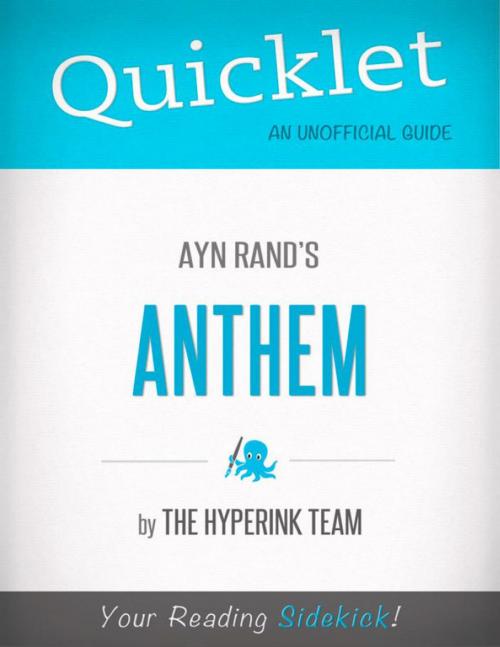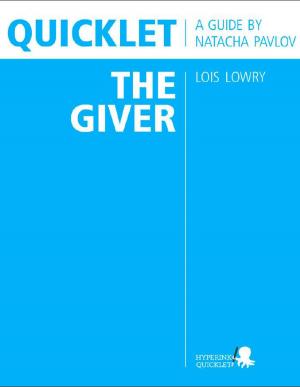Anthem, by Ayn Rand - A Hyperink Quicklet (Objectivism, Architecture)
Nonfiction, Reference & Language, Study Aids, Book Notes, Art & Architecture, General Art| Author: | The Hyperink Team | ISBN: | 9781484006764 |
| Publisher: | Hyperink | Publication: | February 12, 2012 |
| Imprint: | Hyperink | Language: | English |
| Author: | The Hyperink Team |
| ISBN: | 9781484006764 |
| Publisher: | Hyperink |
| Publication: | February 12, 2012 |
| Imprint: | Hyperink |
| Language: | English |
ABOUT THE BOOK
You don’t have to live under a socialist government for Ayn Rand’s Anthem to strike home. Even in the American system, people have a tendency to lose their sense of individuality after childhood. There’s no way to avoid being grouped by class; everyone falls into a category: white collar, blue collar, or something in between. In Anthem, Ayn Rand illuminates a flaw that exists not just in socialist design, but in human nature: a tendency to devalue the individual.
After reading the book, I could not help but consider how often I refer to people in the collective, according to their role in my own life. I define them by their role in society, rather than by their individuality: the car salesman, the plumber, the garbage man. This is the lasting impact of Rand's work: not her courage to speak out against the Russian government, but her warning to all mankind to think. She demands that individualism be respected and stereotypes be ignored. She reminds us to define ourselves from an egocentric perspective, rather than letting the demands of society determine our fates.
MEET THE AUTHOR
The Hyperink Team works hard to bring you high-quality, engaging, fun content. If ever you have any questions about our products, or suggestions for how we can make them better, please don't hesitate to contact us!
Happy reading!
EXCERPT FROM THE BOOK
Rand first developed the concept for her novella Anthem while still in high school. She wanted to write a response to the Russian revolutions she had witnessed, and she originally intended to write it as a theatrical script or screenplay. However, after reading a piece in the Saturday Evening Post about science fiction, she decided that this emerging genre was a better vehicle for her story. She completed the book during the summer of 1937 and began looking for a publisher.
Rand initially offered Anthem to Cassell in Britain and Macmillan in America. Macmillan turned down the offer, but Cassell published the book under the working title Ego on the British market. It was not published in the United States until 1946, when it was printed by two of Rand's friends as a personal favor, under the title Anthem and with changes suggested by Rand. She believed that the original title gave away too much of the book’s purpose, and did not force the reader to consider the message.
The Cassell version became part of the public domain in 1966, at the end of its 28-year copyright. A 50th anniversary edition of the book, containing both the original Cassell publication version and Rand's handwritten notes, was released in 1995. In 2001, the book was adapted by Charles Santino and Joe Staton for use as a graphic novel.
Buy a copy to keep reading!
ABOUT THE BOOK
You don’t have to live under a socialist government for Ayn Rand’s Anthem to strike home. Even in the American system, people have a tendency to lose their sense of individuality after childhood. There’s no way to avoid being grouped by class; everyone falls into a category: white collar, blue collar, or something in between. In Anthem, Ayn Rand illuminates a flaw that exists not just in socialist design, but in human nature: a tendency to devalue the individual.
After reading the book, I could not help but consider how often I refer to people in the collective, according to their role in my own life. I define them by their role in society, rather than by their individuality: the car salesman, the plumber, the garbage man. This is the lasting impact of Rand's work: not her courage to speak out against the Russian government, but her warning to all mankind to think. She demands that individualism be respected and stereotypes be ignored. She reminds us to define ourselves from an egocentric perspective, rather than letting the demands of society determine our fates.
MEET THE AUTHOR
The Hyperink Team works hard to bring you high-quality, engaging, fun content. If ever you have any questions about our products, or suggestions for how we can make them better, please don't hesitate to contact us!
Happy reading!
EXCERPT FROM THE BOOK
Rand first developed the concept for her novella Anthem while still in high school. She wanted to write a response to the Russian revolutions she had witnessed, and she originally intended to write it as a theatrical script or screenplay. However, after reading a piece in the Saturday Evening Post about science fiction, she decided that this emerging genre was a better vehicle for her story. She completed the book during the summer of 1937 and began looking for a publisher.
Rand initially offered Anthem to Cassell in Britain and Macmillan in America. Macmillan turned down the offer, but Cassell published the book under the working title Ego on the British market. It was not published in the United States until 1946, when it was printed by two of Rand's friends as a personal favor, under the title Anthem and with changes suggested by Rand. She believed that the original title gave away too much of the book’s purpose, and did not force the reader to consider the message.
The Cassell version became part of the public domain in 1966, at the end of its 28-year copyright. A 50th anniversary edition of the book, containing both the original Cassell publication version and Rand's handwritten notes, was released in 1995. In 2001, the book was adapted by Charles Santino and Joe Staton for use as a graphic novel.
Buy a copy to keep reading!















